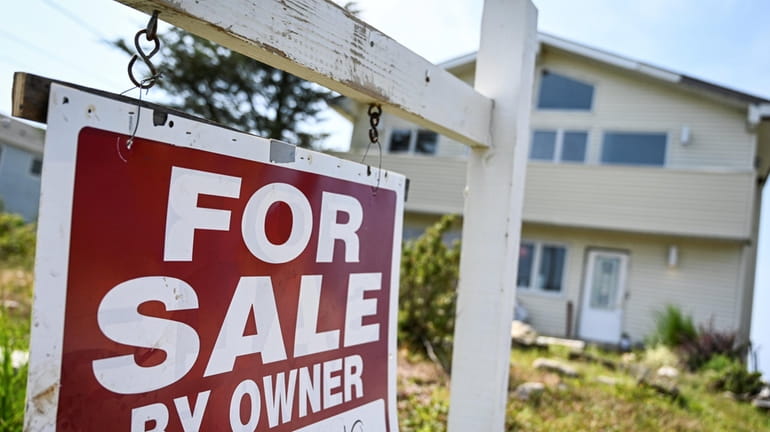Average 30-year fixed mortgage rate rises to 7.49%, highest since 2000

For-sale sign in Mastic. Credit: Newsday/Steve Pfost
The average 30-year fixed mortgage rate rose to its highest level since December 2000 this week, as a sell-off in government bonds helped push rates higher.
The average U.S. rate was 7.49% for the week ending Thursday, jumping up from 7.31% last week, according to mortgage giant Freddie Mac.
It was the was the fourth week in a row in which mortgage rates rose. A year ago, the average was 6.66%. As recently as January 2022, the average was around 3%.
The jump in rates has increased Long Island homebuyers’ monthly payments by hundreds of dollars and fewer people now earn enough to buy a home.
WHAT TO KNOW
- The average rate for a 30-year fixed mortgage rose to 7.49% this week, its highest level since December 2000.
- Higher mortgage rates are making homebuying more expensive for Long Islanders, adding hundreds of dollars to monthly payments.
- Experts pointed to the rising yield on 10-year U.S. Treasury notes, a key benchmark for mortgage rates, as the reason behind the recent upswing.
Interest rates on home loans tend to move in the same direction as the yield on 10-year U.S. Treasury notes, which reached its highest point since 2007 on Wednesday. When investors sell government bonds, prices fall and yields rise.
“Mortgage rates maintained their upward trajectory as the 10-year Treasury yield, a key benchmark, climbed,” Sam Khater, chief economist at Freddie Mac, said in a statement. “Several factors, including shifts in inflation, the job market and uncertainty around the Federal Reserve’s next move, are contributing to the highest mortgage rates in a generation. Unsurprisingly, this is pulling back homebuyer demand.”
A Long Island homebuyer taking out a $500,000, 30-year mortgage at today’s rate would pay $3,492 in principal and interest a month. That’s about 9% more than they would have paid a year ago when the average rate was 6.66%.
If you look back to October 2021, when the average was 2.99%, a borrower’s monthly payment for principal and interest today is about 66% higher, excluding taxes and insurance, which vary by home and community.
When monthly payments rise, borrowers are limited in how much they can spend on a house and still qualify for a mortgage, said Andrew Russell, founder and owner of RCG Mortgage in Hauppauge. He is hopeful that rates will start falling again soon, as potential recession fears begin weighing on the economy, which would push rates lower.
“We’re seeing people losing a lot of purchasing power over the past month,” Russell said.
Higher rates have led to fewer mortgage applications nationwide. An index that tracks applications for mortgages to purchase homes reached its lowest point since 1995 for the week ending Sept. 29, according to the Mortgage Bankers Association in Washington D.C. The index for purchases was down 22% from its level from the same week a year ago.
“Despite the recent jump in rates, we still anticipate that the 30-year fixed-rate mortgage will drop before the end the year, providing some relief to prospective homebuyers heading into 2024,” Bob Broeksmit, president and CEO of the Mortgage Bankers Association, said in a statement.
The average rate for a 15-year fixed home loan was 6.78% this week, which is the highest it has been since June 2001. A year ago, it was 5.90%, according to Freddie Mac.
While higher mortgage rates this year have resulted in fewer deals, Long Island home prices were still rising as recently as August.
The number of sales recorded across Long Island in August was 19% lower than in the same month a year ago.
Meanwhile, the median sale prices in both counties are at records, at $730,000 in Nassau County and $590,000 in Suffolk County. Granted, the data reflects sales that closed in August, so those deals might have been agreed to earlier in the summer.
Russell said he doesn't expect Long Island's shortage of listings — a key driver of higher home prices — to diminish. That’s because homeowners have little financial incentive to sell if they bought or refinanced when rates were low over the past decade.
“If sellers aren’t going to sell when their rates are 2-4% and we get into the 7s, as we veer toward the 8s, they’re definitely not going to sell,” he said.

